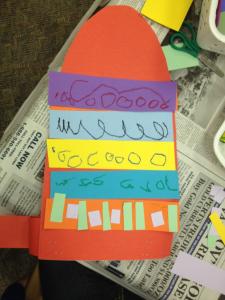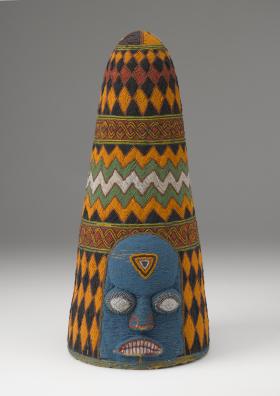Introduction/Warm-Up
- Ask students: Who is wearing a pattern today? Help define pattern by pointing out different patterns on students’ clothing.
- Introduce one of the pattern strips and have students clap as you point to each repeating shape. Repeat with different pattern strip.
- Have students “echo” clap to simple rhythms. Tell them they are clapping to a pattern and when they make their crowns, they will be making a pattern with colors and shapes instead of sounds.
- Show students one last pattern strip, and ask them to speak the shape pattern (i.e. circle, square, circle, square, circle).
- Introduce image Beaded Crown. Ask students what they see in the image.
- Share example of beadwork so that students can feel similar beads and see beads used in similar way.
- Ask students: What is a crown? Where do you wear a crown? Who wears a crown? Discuss.
- Discuss that kings in different places have worn different types of crowns. The Yoruba crown was worn long ago by a king who lived in Africa.
Focus Activity Procedure
- Demonstrate how to draw a pattern with oil pastels on strips of construction paper.
- Demonstrate how to glue the patterned strips of paper onto the “crown” paper. Students can also make a pattern with the paper strips by placing them in alternating colors.
- Demonstrate another way to create a pattern by cutting small construction paper shapes and gluing them to the background of the crown or onto the strips of paper.
- Excuse students to their seats to work.
- While students are working, walk around room and staple the straps around the back of each student’s head. Crowns can still lay flat once they have been stapled.
Closing
- Clean up.
- Gather class for closing routine and conversation. Hold up one or two of the “crowns,” and have the class clap a pattern they see on one of the paper strips.
- Invite students to wear their crowns as they clap in a pattern. Students can also be invited to dance or stomp in a pattern. If time allows, students may have a “ royal pattern parade” around the classroom, stomping or clapping while speaking a pattern. (i.e. Queens and Kings! Queens and Kings!)
- Ask students to look for art all around them at home and at school.
- While showing the image of Beaded Crown, ask recall questions about the artwork to assess listening skills and understanding. For example: Who can tell me what this is? A crown Who might have worn this? Possible responses: a king, someone important What is it made of? Possible responses: beads, glass beads Where did this crown come from? Possible responses: far away, Africa
- Observe student work in process and in completion to assess if students were able to create repeating patterns. Look for patterns using shapes, lines and colors.
- Assess whole class understanding of pattern concept during closing by observing students’ ability to mirror stomp and clap patterns.
pattern
repeat
crown
bead
Assorted colors Railroad board “crown” backgrounds (pre-cut and assembled, about 9.5” wide by 17.5” tall, 1 per student, see PDF instructions below)
Assorted colors construction paper strips (pre-cut, about 9” long)
Oil pastels
Assorted colors construction paper scraps
Scissors
Nontoxic glue
Optional sample of beadwork (beaded belt, purse or other)
Globe or map to show the location of Africa
Large strips of paper with simple patterns on them to use during introduction to lesson
Extension Activities for Teachers
- Invite students to find patterns in classroom. Discuss how some clothing is worn for special occasions (like the crown) and some clothes are worn every day. Ask students if other things they wear could be considered art (jewelry, eyeglasses, hair clips). Why or why not?
Extension Activities for Families
- Look at family pictures of people in special clothing (a wedding dress, a prom tuxedo). Discuss clothing you wear for special occasions.
Suggested Books for Classroom Library
Brocket, Jane. Spotty, Stripy, Swirly: What Are Patterns? Millbrook, 2012. [ISBN 978-0-7613-4613-5]
Bryan, Ashley. Beautiful Blackbird. Simon/Atheneum, 2003. [ISBN 978-0-689-84731-8]
Chocolate, Deborah M. Newton. Kente Colors. Illustrations by John Ward. Walker, 1997,[ISBN 978-1-41312-866-6]
Ehlert, Lois. Feathers For Lunch. Harcourt, 1990. [ISBN 978-0-15-230550-5]
Ehlert, Lois. Lots of Spots. Simon/Beach Lane, 2010. [ISBN 973-1-44240-289-8]
Kuskowski, Alex. Super Simple African Art: Fun and Easy Art from Around the World. ABDO, 2012. [ISBN 973-1-61783-210-9]
Morris, Ann. Hats, Hats, Hats. Photographs by Ken Heyman. Lothrop, 1989. [ISBN 978-0-688-06338-2]
Pluckrose, Henry Arthur. Pattern. Childrens Press, 1995, 1994. [ISBN 973-0-329-56924-2]
Swinburne, Stephen R. Lots and Lots of Zebra Stripes: Patterns in Nature. Boyds Mills, 2001, 1998. [ISBN 978-0-329-59955-3]


Among the Yoruba, each oba (ruler) has authority over a city-state, a city or town and its surrounding territories. For ceremonial occasions, the oba wears a conical beaded crown within which are sealed powerful herbal medicines. The tiny glass beads used here are typical for crowns made in the nineteenth and twentieth centuries, when Yoruba beadworkers (who were always male) replaced the traditional red beads of coral or carnelian with multicolored glass “seed beads” obtained through trade with Europeans.
Faces on either side of the crown may refer to Olokun, god of the sea and “owner of the beads”; to ancestors of the oba; or to the “inner [spiritual] face” of the oba himself. They also serve as a reminder that the oba sees and hears all, even that which takes place behind his back. Other designs include an interlace pattern symbolic of the ruler’s power, and zigzag motifs representing energy and/or the lightning bolts of the god Shango. The elongated shape of the crown emphasizes the importance of the head, which the Yoruba believe to be the center of an individual’s character, destiny, and spirituality.
Although generally well preserved, the crown may have suffered some losses. Often a veil of beads hangs over the oba’s face, separating him from earthly concerns and uniting him with the spiritual realm. In addition, a three-dimensional beaded bird may surmount such a crown as a symbol of the spiritual power of older women, called “our mothers,” whose support and cooperation is essential to the oba’s successful rule. It is also possible that the crown never had these features, for rulers wore simpler or more elaborate conical crowns, depending on the occasion.


